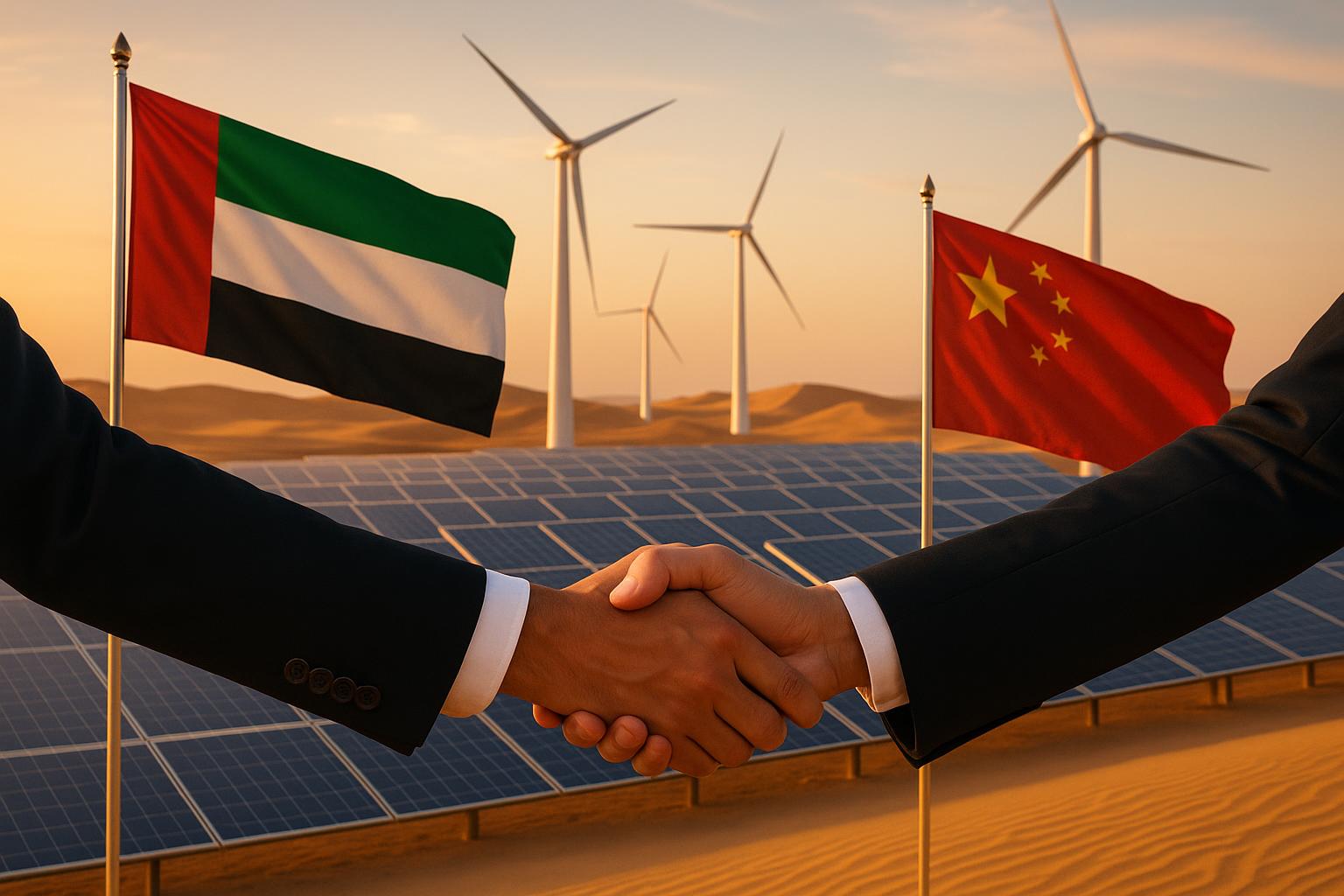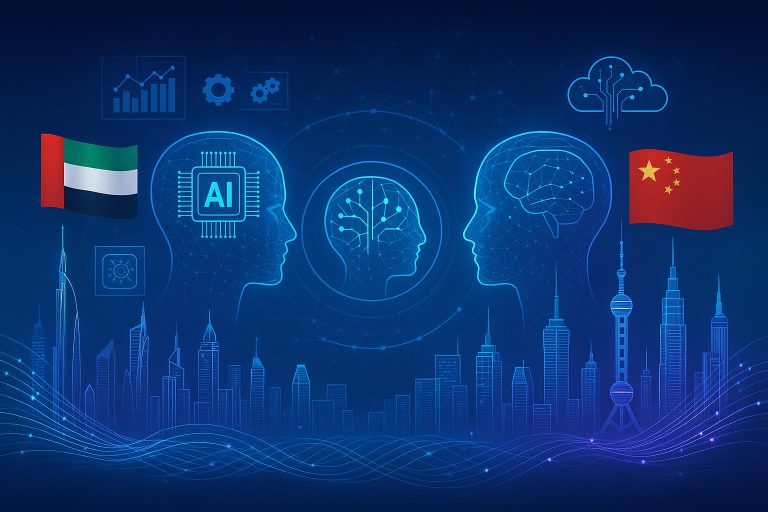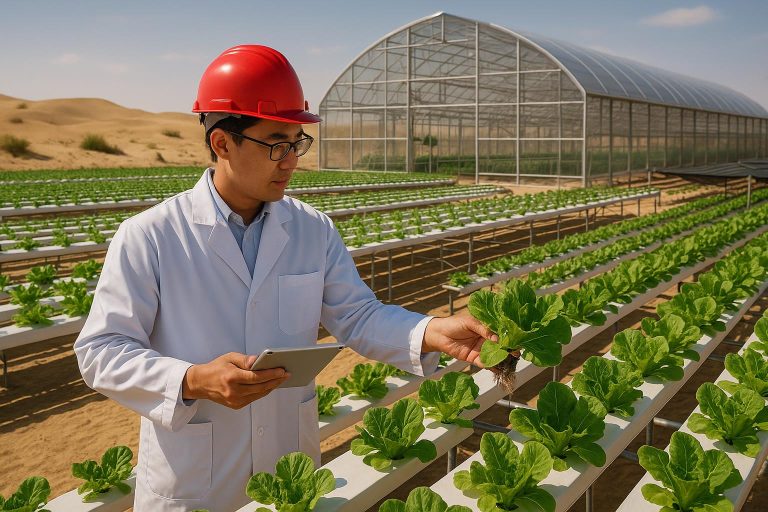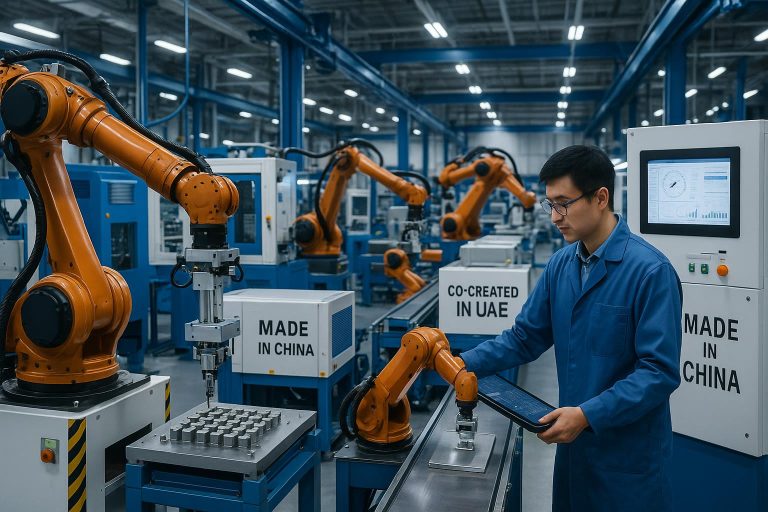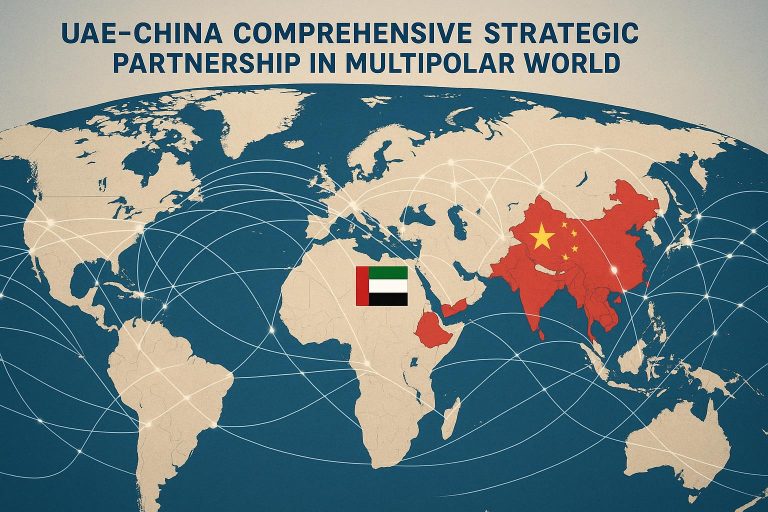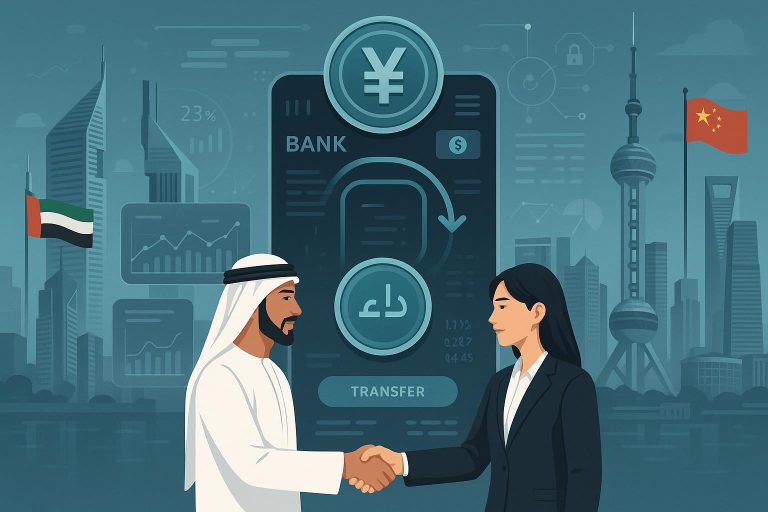The Green Silk Road: Analyzing Sino-UAE Leadership in the Global Renewable Energy Transition
1. Executive Summary
In an era defined by the urgent need for global energy transition, the United Arab Emirates (UAE) and China are emerging as pivotal leaders, particularly within the framework of the ‘Green Silk Road’ initiative. This article analyzes the deepening bilateral cooperation between these two nations, highlighting their strategic investments and collaborative efforts in renewable energy. With bilateral trade reaching a record $101.8 billion in 2024 and significant UAE investments in China, their comprehensive strategic partnership, established in 2018, is driving substantial progress in solar, wind, and other clean energy sectors. While acknowledging challenges, this analysis underscores the immense opportunities for sustainable growth and offers strategic recommendations for further solidifying their joint leadership in shaping a greener global energy future.
2. Introduction
The global imperative to transition towards sustainable energy sources has never been more critical. As nations worldwide grapple with climate change and energy security concerns, the collaboration between key players becomes paramount. Among these, the partnership between the United Arab Emirates and China stands out as a dynamic force, particularly in advancing the global renewable energy agenda. This article delves into the multifaceted dimensions of their cooperation, framed within the ambitious vision of the ‘Green Silk Road.’ This initiative extends beyond traditional infrastructure, encompassing green development, environmental protection, and sustainable investment, with renewable energy at its core. Both nations, each with unique strengths—the UAE as a forward-thinking energy hub and China as a global manufacturing and technological powerhouse—are strategically aligning their interests to foster innovation, drive investment, and implement large-scale renewable energy projects. This analysis will explore the historical context, current landscape, strategic drivers, inherent challenges, and future trajectory of Sino-UAE leadership in the global renewable energy transition, offering insights into their potential to accelerate a sustainable future.
3. The Current Landscape of Bilateral Cooperation
The relationship between the UAE and China has evolved into a comprehensive strategic partnership, marked by robust economic ties and expanding collaboration across diverse sectors. This deepening alliance is underpinned by impressive trade figures and mutual investment. Bilateral trade between the two nations reached a record $101.8 billion in 2024, representing an astounding 800-fold growth since 1984. This makes the UAE China’s largest export market in the Middle East and its second-largest trading partner in the region, while China consistently remains the UAE’s largest trading partner. The presence of over 15,000 Chinese firms operating in the UAE further underscores the vibrant economic exchange. Concurrently, UAE investments in China have seen significant growth, reaching $4.5 billion by the end of 2023, a 96% increase from the previous year.
This robust economic foundation is supported by a strong strategic partnership framework, formally established in 2018. Regular high-level diplomatic engagements and strategic agreements, including the formation of the UAE-China Investment and Economic Cooperation Working Group, facilitate policy coordination and investment promotion. The Belt and Road Initiative (BRI) has been a significant catalyst, with projects totaling $3.1 billion in the UAE, further integrating the UAE into global trade routes and enhancing its role as a critical logistics hub for China-Middle East trade.
Key cooperation sectors extend beyond traditional trade to encompass critical areas for sustainable development. Energy, particularly clean energy, stands out as a priority. Investments in solar and wind power projects are prominent, exemplified by the Masdar-China Silk Road Fund Memorandum of Understanding (MoU) aimed at developing renewable energy projects in BRI countries. This initiative aligns perfectly with the ‘Green Silk Road’ concept, channeling capital and expertise towards sustainable infrastructure.
Infrastructure and logistics also form a cornerstone of this partnership. The COSCO terminal at Khalifa Port and the China-UAE Industrial Capacity Zone highlight the UAE’s strategic positioning as China’s gateway to the Gulf. Technology and AI represent another burgeoning area, with numerous cooperation agreements and digital transformation initiatives fostering innovation. Furthermore, collaborations in trade and free zones, such as JAFZA’s partnerships with Chinese free trade zones and DP World’s extensive engagements, optimize supply chains and facilitate cross-border commerce. The financial sector also plays a crucial role, with cross-border investment facilitation and fintech partnerships enhancing the flow of capital and supporting joint ventures. These multifaceted engagements demonstrate a strategic alignment that positions both nations to collectively lead in the global renewable energy transition and broader sustainable development efforts.
Recent developments in 2024-2025 further solidify this partnership, with multiple MoUs signed between various chambers and organizations, and high-level visits reinforcing diplomatic ties. There is a growing focus on new economy sectors, entrepreneurship, tourism, and aviation, indicating a diversification of cooperation beyond traditional areas. Abu Dhabi has emerged as a primary investment hub, while Dubai continues its vital role in trade facilitation, complemented by free zone partnerships across various emirates. This comprehensive and evolving landscape of bilateral cooperation provides a strong foundation for their joint leadership in the global renewable energy transition.
4. Opportunities and Strategic Growth Drivers
The Sino-UAE partnership is uniquely positioned to capitalize on a multitude of opportunities and strategic growth drivers that propel the global renewable energy transition, particularly under the ambit of the Green Silk Road. The convergence of China’s technological prowess and manufacturing capacity with the UAE’s strategic location, investment capital, and ambitious renewable energy targets creates a powerful synergy.
Energy & Clean Energy: The core of this collaboration lies in renewable energy. China, as a global leader in solar panel and wind turbine manufacturing, offers cost-effective solutions and advanced technologies. The UAE, through entities like Masdar, is a significant investor and developer of renewable energy projects globally. The Masdar-China Silk Road Fund MoU for renewable energy projects in BRI countries exemplifies a direct strategic growth driver, channeling investments into sustainable infrastructure across the Belt and Road regions. This not only supports the UAE’s energy diversification goals but also extends China’s green technology footprint, fostering a virtuous cycle of innovation and deployment.
Infrastructure & Logistics: The UAE’s role as a critical logistics hub for China-Middle East trade, reinforced by projects like the COSCO terminal at Khalifa Port and the China-UAE Industrial Capacity Zone, provides a robust framework for the Green Silk Road. Efficient logistics are crucial for the deployment of large-scale renewable energy components and equipment. This infrastructure facilitates the movement of goods and expertise, reducing costs and accelerating project timelines for green initiatives across the region and beyond.
Technology & AI: The strategic partnership extends deeply into technology and artificial intelligence, areas critical for optimizing renewable energy systems and developing smart grids. The $5 billion partnership for AI, renewable energy, and infrastructure, alongside initiatives like Digital Dubai exploring AI and smart city technologies in Shenzhen, highlights a shared vision for leveraging cutting-edge solutions. AI can enhance predictive maintenance for solar farms, optimize energy distribution, and improve the efficiency of renewable energy integration into national grids, positioning both nations at the forefront of energy innovation.
Finance & Investment: The Belt and Road Initiative (BRI) has already seen $3.1 billion in projects in the UAE, demonstrating a strong financial commitment. Cross-border investment facilitation and fintech partnerships, including China’s CIPS and UAE central bank cooperation on cross-border payments, are streamlining financial flows for green projects. The launch of ETF products and broader financial industry cooperation further mobilizes capital for renewable energy ventures, ensuring sustained funding for ambitious projects.
Diversification into New Economy Sectors: Recent developments (2024-2025) show a clear focus on new economy sectors, entrepreneurship, tourism, and aviation. While seemingly disparate, these sectors indirectly support the green transition. For instance, the $1 billion deal for 350 flying taxis (eVTOL aircraft) signifies a commitment to future-oriented, potentially electric-powered transportation, aligning with broader decarbonization efforts. Similarly, sustainable tourism initiatives and green building practices in hospitality can contribute to a lower carbon footprint. The expansion of healthcare, agriculture, and logistics sectors with a focus on smart and sustainable practices (e.g., hydroponics, smart supply chains) further diversifies the economic base while embedding green principles.
Overall, the strategic alignment of economic interests, technological capabilities, and a shared vision for sustainable development creates unparalleled opportunities for the UAE and China to lead the global renewable energy transition. Their collaborative model serves as a blueprint for how international partnerships can effectively address climate change while fostering economic growth.
5. Challenges and Critical Considerations
While the Sino-UAE partnership presents significant opportunities for advancing the global renewable energy transition, it is also imperative to acknowledge and critically consider potential challenges and complexities. A balanced perspective requires examining these factors to ensure the long-term sustainability and effectiveness of their joint leadership.
Geopolitical and Economic Volatility: The global energy landscape is subject to geopolitical shifts and economic volatility. Fluctuations in global oil prices, while less directly impacting renewable energy projects, can influence national budgets and investment priorities. Furthermore, broader international relations and trade tensions, particularly between major global powers, could indirectly affect the operational environment for both Chinese and UAE companies engaged in international projects. Maintaining a neutral and stable investment climate amidst such dynamics is crucial.
Technological Integration and Standardization: While both nations possess advanced technological capabilities, ensuring seamless integration and standardization of diverse technologies from different origins can be a challenge. As renewable energy projects become more complex, involving smart grids, energy storage, and AI-driven optimization, interoperability and common technical standards will be vital. Differences in regulatory approaches to technology adoption and intellectual property protection could also require careful navigation.
Supply Chain Dependencies and Resilience: The global renewable energy supply chain, particularly for critical components like rare earth minerals and specialized manufacturing, often has concentrated points of origin. While China is a dominant player in many of these areas, over-reliance on a single source can pose risks related to supply disruptions, price volatility, or geopolitical leverage. Diversifying supply chains and building regional manufacturing capabilities within the UAE or other BRI countries could enhance resilience.
Policy Alignment and Regulatory Harmonization: Both the UAE and China have distinct legal, regulatory, and policy frameworks. While efforts are underway to harmonize investment and trade policies, differences can still create complexities for cross-border projects. Ensuring consistent policy support, clear contractual frameworks, and efficient dispute resolution mechanisms are essential for attracting and securing long-term investments in renewable energy. The pace of regulatory evolution in rapidly developing sectors like AI and green finance also demands continuous coordination.
Human Capital Development and Local Content: To truly foster sustainable leadership, the partnership must prioritize human capital development and local content creation within the UAE. While Chinese expertise and labor are often deployed in large-scale projects, ensuring knowledge transfer, training local workforces, and developing indigenous research and development capabilities are critical for the UAE to become a self-sufficient leader in renewable energy. A lack of focus on local capacity building could lead to dependency rather than shared leadership.
Financial Risk Management: Large-scale renewable energy projects require substantial capital and often involve long payback periods. While both nations have significant financial resources, managing financial risks, including currency fluctuations, project financing structures, and ensuring attractive returns on investment, remains a critical consideration. The effectiveness of financial instruments like the Masdar-China Silk Road Fund will depend on robust risk assessment and transparent governance.
Addressing these challenges proactively through continuous dialogue, adaptive policy-making, and strategic investments in resilience and local capabilities will be paramount for the UAE and China to solidify their joint leadership in the global renewable energy transition and ensure the enduring success of the Green Silk Road initiative.
6. Case Study Spotlight
To illustrate the tangible impact of Sino-UAE collaboration in the renewable energy sector, a compelling case study is the Masdar-China Silk Road Fund Memorandum of Understanding (MoU). This strategic partnership exemplifies the practical application of the Green Silk Road initiative and the commitment of both nations to global sustainable development.
Masdar, Abu Dhabi Future Energy Company, is a global leader in renewable energy and sustainable urban development. Its collaboration with Chinese entities under the umbrella of the Silk Road Fund, China’s medium-to-long term development and investment fund, is designed to jointly invest in renewable energy projects within countries participating in China’s Belt and Road Initiative (BRI). This MoU, while specific in its focus, represents a broader strategic alignment:
- Joint Investment Platform: The fund creates a dedicated financial vehicle for deploying capital into viable renewable energy projects, such as solar and wind farms, across diverse geographies. This mitigates investment risks and leverages the financial strengths of both partners.
- Technology Transfer and Expertise Sharing: China’s extensive experience in manufacturing and deploying renewable energy technologies, coupled with Masdar’s expertise in project development and operation in challenging environments, fosters a rich exchange of knowledge and best practices. This accelerates the adoption of advanced green technologies.
- Global Reach of the Green Silk Road: By targeting BRI countries, the initiative extends the impact of Sino-UAE cooperation beyond their bilateral relationship, contributing directly to the energy transition goals of developing nations. This aligns with the broader vision of the Green Silk Road, which emphasizes sustainable infrastructure and environmental protection along the ancient trade routes.
- Strategic Alignment with National Visions: For the UAE, this partnership supports its diversification agenda and its ambition to be a global leader in clean energy. For China, it reinforces its commitment to green development under the BRI and strengthens its position as a provider of sustainable solutions worldwide.
This case study underscores how the UAE and China are not merely engaging in trade but are actively co-creating mechanisms for sustainable development, demonstrating a shared vision and practical commitment to leading the global renewable energy transition through concrete, impactful projects.
7. Future Outlook and Strategic Recommendations
The future outlook for Sino-UAE leadership in the global renewable energy transition, particularly through the Green Silk Road, is exceptionally promising, albeit requiring continuous strategic foresight and adaptive collaboration. Both nations are poised to deepen their engagement, leveraging their complementary strengths to accelerate sustainable development globally. The trajectory suggests an increasing integration of green technologies, sustainable finance, and policy coordination.
Strategic Recommendations:
- Enhance Green Technology Transfer and Localization: To mitigate supply chain dependencies and foster local capabilities, the UAE and China should establish joint research and development centers focused on next-generation renewable energy technologies, such as advanced solar materials, energy storage solutions, and smart grid systems. This should include programs for training Emirati talent in manufacturing, installation, and maintenance of these technologies, ensuring a robust local content component.
- Develop Standardized Green Finance Mechanisms: Building on existing financial cooperation, both nations should work towards developing standardized green finance products and platforms. This includes green bonds, sustainability-linked loans, and investment funds specifically targeting renewable energy projects within the BRI framework. Harmonizing regulatory frameworks for green finance can attract a broader base of international investors and streamline capital deployment.
- Strengthen Policy Dialogue and Regulatory Alignment: Regular high-level dialogues should be institutionalized to address emerging policy and regulatory challenges in the renewable energy sector. This includes aligning standards for environmental impact assessments, carbon accounting, and renewable energy certification. Such alignment would create a more predictable and attractive investment environment for joint ventures.
- Expand Cooperation in Emerging Green Sectors: Beyond traditional solar and wind, the partnership should explore new frontiers such as green hydrogen production, carbon capture utilization and storage (CCUS), and sustainable urban development. The UAE’s abundant solar resources and China’s technological expertise make green hydrogen a particularly promising area for joint investment and innovation.
- Promote Human Capital Development and Knowledge Exchange: Implement comprehensive exchange programs for students, researchers, and professionals in renewable energy. This would facilitate the transfer of technical know-how, foster cross-cultural understanding, and build a shared talent pool capable of driving future innovations. Focus on vocational training and specialized engineering programs.
- Leverage Digital Transformation for Energy Efficiency: Utilize AI and big data analytics, areas where both nations are making significant strides, to optimize energy consumption, predict renewable energy output, and manage smart grids more effectively. Joint pilot projects in smart cities or industrial zones could showcase integrated green and digital solutions.
By proactively addressing potential challenges and strategically investing in these areas, the UAE and China can not only solidify their leadership in the global renewable energy transition but also set a powerful example for international cooperation in tackling climate change and fostering sustainable economic growth. Their combined efforts along the Green Silk Road have the potential to redefine global energy paradigms for decades to come.
8. Conclusion
The strategic partnership between the United Arab Emirates and China has evolved into a powerful force driving the global renewable energy transition, particularly through the lens of the Green Silk Road. This collaboration, rooted in robust economic ties and a shared vision for sustainable development, demonstrates how two nations with diverse backgrounds can synergize their strengths to address one of humanity’s most pressing challenges. From record-breaking bilateral trade figures to comprehensive strategic agreements and joint investments in clean energy projects, the Sino-UAE alliance is not merely transactional but transformative.
While the path forward is not without its challenges—including geopolitical complexities, technological integration hurdles, and the need for continuous human capital development—the proactive engagement of both countries in addressing these considerations positions them for sustained leadership. The Masdar-China Silk Road Fund MoU stands as a testament to their practical commitment, channeling capital and expertise into tangible green initiatives across the Belt and Road regions. By fostering innovation, aligning policies, and expanding into new green sectors, the UAE and China are setting a compelling example of international cooperation. Their combined efforts are not only accelerating their own energy diversification and green development goals but are also significantly contributing to a more sustainable and resilient global energy future.
9. References
[1] UAE-China Bilateral Investment Research Findings (Provided Research Document)

